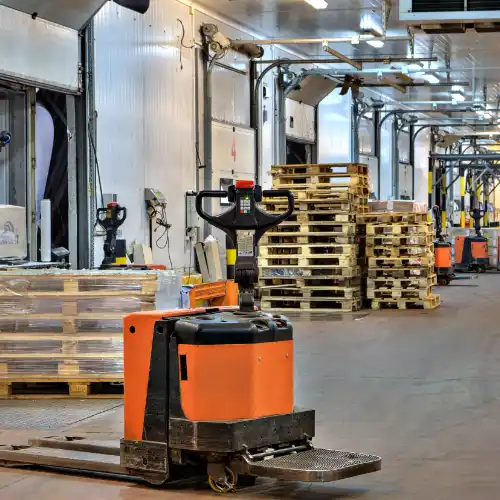OSHA’s #8 Most Cited Violation of 2025: Powered Industrial Trucks (1910.178)
P o w e r e d I n d u s t r i a l T r u c k s 1, 826 violations — Dropped to #8 after 422 fewer citations.

Forklifts & Powered Industrial Trucks — Operator Training, Maintenance, and Safe Use
Forklifts are essential to manufacturing, warehousing, construction, and distribution work — but they remain one of the most dangerous pieces of equipment on any site. In FY 2025, OSHA cited 1,826 violations under 1910.178, moving this hazard down to #8 thanks to 422 fewer citations than the previous year.
Even with the decrease, Powered Industrial Trucks (PITs) continue to cause serious injuries, fatalities, property damage, and costly OSHA fines. For safety directors like Steve, purchasing agents like Alex, and plant managers like Pete, forklift compliance remains a top priority.
Why Forklift Violations Stay in OSHA’s Top 10
OSHA consistently finds the same issues across facilities. Here’s what drives most citations:
1. Inadequate Operator Training
This is the #1 cause of PIT citations.
OSHA requires:
- Initial formal instruction (classroom/online)
- Practical, hands-on training
- Evaluation every 3 years
- Additional training when new hazards, attachments, or equipment are introduced
Common citation triggers:
- No documentation
- Outdated evaluations
- Temporary workers not trained
- Supervisors not enforcing certification checks
2. Poor Forklift Inspection & Maintenance
Daily pre-shift inspections are mandatory.
Citations arise from:
- No inspection records
- Operating forklifts with known issues
- Damaged forks, tires, or masts
- Dead or bypassed safety alarms
- Leaking hydraulics
- Faulty brakes or steering
A forklift is never allowed to operate if it’s unsafe — but many facilities are cited for ignoring defects to “keep production moving.”
3. Unsafe Operating Practices
OSHA observes behaviors such as:
- Speeding
- Loads too high or improperly balanced
- No seatbelt use
- Carrying passengers
- Driving with obstructed view
- Forks elevated while traveling
- Operating near edges, docks, or pedestrians
These behaviors lead to the majority of serious forklift accidents.
4. Wrong Truck for the Environment
A commonly overlooked violation:
Examples:
- Using non-EX (non-explosion-proof) trucks in hazardous locations
- Internal combustion forklifts used indoors without ventilation
- Electric trucks used outdoors in wet or corrosive environments
- Attachments not rated or approved by the manufacturer
The wrong classification can lead to both citations and catastrophic incidents.
5. Lack of Pedestrian Safety Controls
Facilities are cited for:
- No marked forklift lanes
- No pedestrian warnings or barriers
- Blind corners without mirrors
- No audible alarms
- No communication procedures
Forklifts and pedestrians must not share uncontrolled space.
How to Stay Compliant with OSHA 1910.178 in 2025
✔ Train & Certify Every Operator
You must provide:
- Classroom training
- Hands-on evaluation
- Documentation for each operator
- Site-specific training
Temporary employees and short-term workers count too.
✔ Perform Daily PIT Inspections
Checks should cover:
- Tires
- Forks and mast
- Hydraulics
- Brakes & steering
- Lights & horns
- Seatbelts
- Batteries (for electrics)
- LP tanks or fuel systems
Inspections must be documented and retained.
✔ Maintain Clear Pedestrian Controls
Implement:
- Floor striping
- Walkways
- Mirrors
- Warning alarms
- Blue spot lights or red line lasers
- “Forklift Traffic Only” zones
✔ Choose the Right Forklift for Your Environment
Verify:
- Classifications (I–VII)
- Hazardous environment requirements
- Electrical classifications
- Attachments approved in writing by manufacturer
✔ Refresh Training Regularly
Even though OSHA requires re-evaluation every 3 years, best practice is annual refresher training, especially after:
- Near misses
- Change in equipment
- New attachments
- Changes in layout or product flow
How Advanced Safety & Industrial Supply Supports PIT Safety
Advanced Safety & Industrial Supply helps companies stay compliant with OSHA’s forklift requirements through
OSHA-compliant forklift training (onsite or virtual)
Operator recertifications & evaluations
PIT inspection checklists
Facility pedestrian safety assessments
Blue/red safety lighting solutions
Fall protection & PPE to pair with forklift zones
Mock OSHA audits
Let our team help your facility reduce citations, prevent accidents, and protect your workforce.
Call (615) 739-3278 or Contact Us now to schedule training or an onsite evaluation.

















